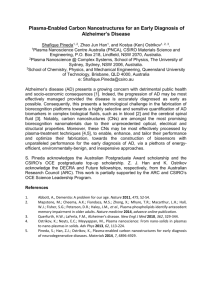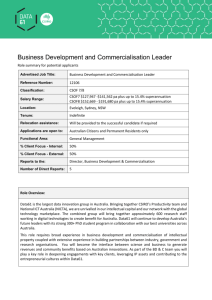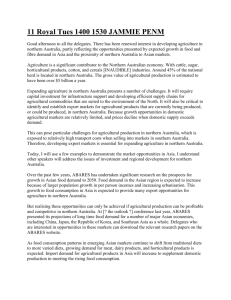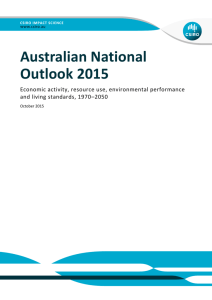Australian National Outlook 2015 * Insights for food, water
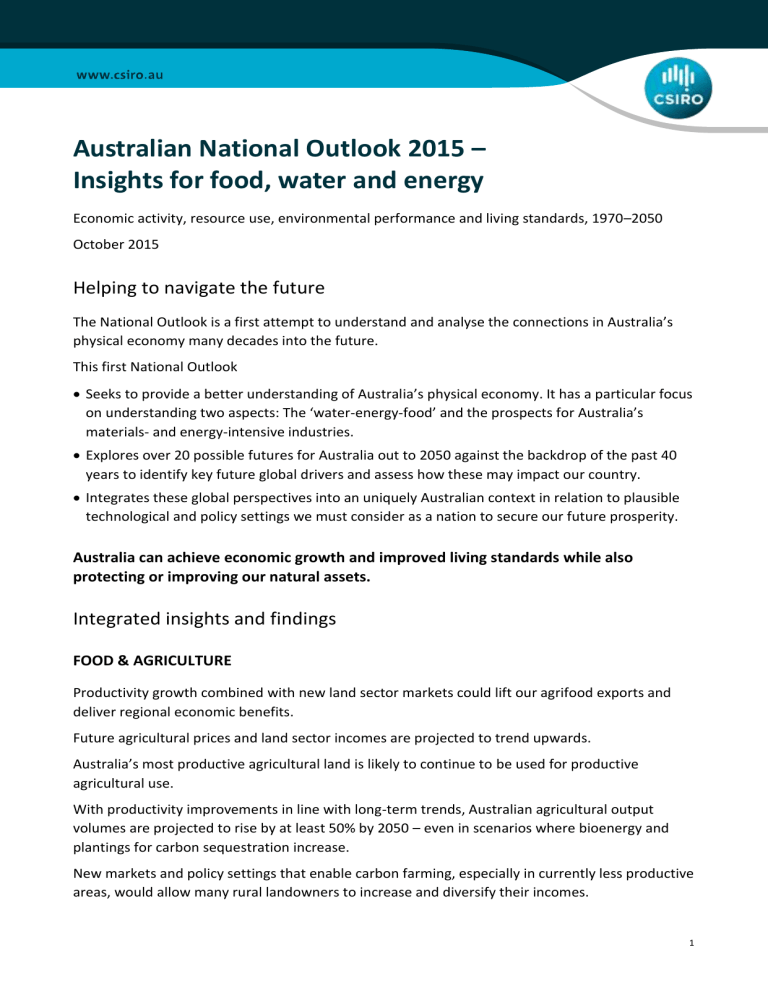
Australian National Outlook 2015 –
Insights for food, water and energy
Economic activity, resource use, environmental performance and living standards, 1970–2050
October 2015
Helping to navigate the future
The National Outlook is a first attempt to understand and analyse the connections in Australia’s physical economy many decades into the future.
This first National Outlook
Seeks to provide a better understanding of Australia’s physical economy. It has a particular focus on understanding two aspects: The ‘water-energy-food’ and the prospects for Australia’s materials- and energy-intensive industries.
Explores over 20 possible futures for Australia out to 2050 against the backdrop of the past 40 years to identify key future global drivers and assess how these may impact our country.
Integrates these global perspectives into an uniquely Australian context in relation to plausible technological and policy settings we must consider as a nation to secure our future prosperity.
Australia can achieve economic growth and improved living standards while also protecting or improving our natural assets.
Integrated insights and findings
FOOD & AGRICULTURE
Productivity growth combined with new land sector markets could lift our agrifood exports and deliver regional economic benefits.
Future agricultural prices and land sector incomes are projected to trend upwards.
Australia’s most productive agricultural land is likely to continue to be used for productive agricultural use.
With productivity improvements in line with long-term trends, Australian agricultural output volumes are projected to rise by at least 50% by 2050 – even in scenarios where bioenergy and plantings for carbon sequestration increase.
New markets and policy settings that enable carbon farming, especially in currently less productive areas, would allow many rural landowners to increase and diversify their incomes.
1
WATER & ENVIRONMENT
With appropriate settings and technologies, projected increases in water demand need not increase pressure on water limited catchments.
Payments for carbon sequestration could be harnessed to reward rural land owners for restoring ecosystems, increasing native habitat by 17% and decreasing extinction risks by 10%, without large additional government outlays.
Non-agricultural water use is projected to increase by 65 to 150% by 2050, while the value of national economic output increases by more than 150%.
While water use is projected to double by 2050, this growth can be met while enhancing urban water security and avoiding increased environmental pressures through increased water recycling, desalination and integrated catchment management.
ENERGY
Australia has the natural and institutional resources to prosper in almost all scenarios for global energy and resource use.
Global demand for exports is projected to treble by 2050 as global per capita income also trebles.
We should expect long term growth of world energy demand, but demand for specific materials and energy exports could vary. Even in scenarios with strong global action to reduce emissions, energy and other resources could remain one of the pillars of the Australian economy, as long as commercially viable technology solutions are developed in a timely fashion to manage environmental impacts.
Domestically, energy affordability can improve, especially when we enhance the efficiency and productivity of the energy system. Transport affordability might also improve, especially through the large-scale adoption of electric vehicles.
Efficient and responsive institutional settings can turn challenges into opportunities, and have a vital role in managing tradeoffs and promoting longer term sustainability and prosperity.
Positioning Australia for the decades ahead
The National Outlook scenarios – alternative Australian futures – set the stage for a national conversation about the kind of future that would best serve all Australians and the choices and mechanisms that might get us there.
The future of our nation, industries and communities will depend on how we position for change, and adapt as the world around us evolves. The National Outlook research shows that
Agility, innovation and productivity are no regret moves that will help us to make the most of a positive – but uncertain – global economic outlook.
2
Sustainability and economic growth can be partners not competitors. Productivity growth and establishing economically efficient mechanisms such as markets will be vital to achieving this outcome.
The decisions we make as a society will shape Australia’s future more than decisions we make as businesses or individuals and determine our future prosperity.
NATIONAL OUTLOOK REPORTS
The full findings and results from the National Outlook project will be published in the Australian
National Outlook 2015, a detailed technical report, and more than ten science papers written for peer reviewed journals. These reports and papers will be available from mid-2015 at www.csiro.au/nationaloutlook t e w
FOR FURTHER INFORMATION
Dr Alex Wonhas
CSIRO Executive Director
Energy and Resources
+61 2 9490 5059 alex.wonhas@csiro.au
www.csiro.au
Dr Steve Hatfield-Dodds
Project Director, CSIRO Australian National Outlook 2015 t e w
+61 2 6246 5597 steve.hatfield-dodds@csiro.au
www.csiro.au
3

